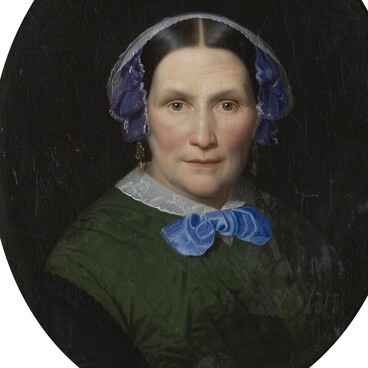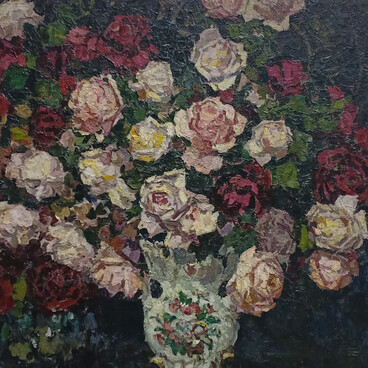Alexey Mikhailovich Kolesov was an artist, portraitist, and icon painter. The National Art Museum of the Sakha Republic houses his work “Portrait of a Senator”, painted in 1874.
The presented canvas is a typical ceremonial portrait, which is mainly characterized by a depiction of the sitter as a representative of his or her social group, an attempt to express their dignity. The portrait reliably conveys the historical context, in which the sitter lived. His proud posture, the splendor of the ceremonial uniform embroidered with gold threads, and awards worn for special occasions attract the viewer’s attention. Skillfully painted side lighting reveals the characteristic shape of the head and noble facial features. The moiré ribbon, the beauty of the ceremonial uniform, the vibrant combinations of red and gold, and the simplicity and rigor of forms convey the solemnity of the portrayed. He is an important, successful person with an excellent reputation. But his personal traits are hidden behind his ceremonial uniform.
Alexey Mikhailovich Kolesov was born in 1834 in Kovrov. At the age of 17, he went on foot to study painting in Moscow, where he was accepted into Art Classes (later — the School of Painting and Sculpture). In 1856, the Imperial Academy of Arts awarded him the title of a free portraitist for his study depicting an old man.
During his lifetime, Alexey Mikhailovich was always considered a skilled artist. In the 1880s, a number of significant changes happened in his work. He moved away from secular art and turned to icon painting. His successes in this field were so extraordinary that soon he headed the Moscow School of Icon Painting.
The artist Igor Grabar sometimes visited the School of Icon Painting, in his autobiography he wrote about it: “This visit brought me great joy. In addition to the boring, unexciting saints with halos — commissioned works for various parish churches — I saw in the studio of the artist Kolesov a small painting he had begun, depicting a peasant boy with a bird’s nest in his hands. It seemed to me that the boy’s head, already finished, was quite exceptional in terms of the facial expression and vibrancy of colors, and the hands, which the artist had only started, were the height of perfection in terms of his skillful and bold brushwork.”
The presented canvas is a typical ceremonial portrait, which is mainly characterized by a depiction of the sitter as a representative of his or her social group, an attempt to express their dignity. The portrait reliably conveys the historical context, in which the sitter lived. His proud posture, the splendor of the ceremonial uniform embroidered with gold threads, and awards worn for special occasions attract the viewer’s attention. Skillfully painted side lighting reveals the characteristic shape of the head and noble facial features. The moiré ribbon, the beauty of the ceremonial uniform, the vibrant combinations of red and gold, and the simplicity and rigor of forms convey the solemnity of the portrayed. He is an important, successful person with an excellent reputation. But his personal traits are hidden behind his ceremonial uniform.
Alexey Mikhailovich Kolesov was born in 1834 in Kovrov. At the age of 17, he went on foot to study painting in Moscow, where he was accepted into Art Classes (later — the School of Painting and Sculpture). In 1856, the Imperial Academy of Arts awarded him the title of a free portraitist for his study depicting an old man.
During his lifetime, Alexey Mikhailovich was always considered a skilled artist. In the 1880s, a number of significant changes happened in his work. He moved away from secular art and turned to icon painting. His successes in this field were so extraordinary that soon he headed the Moscow School of Icon Painting.
The artist Igor Grabar sometimes visited the School of Icon Painting, in his autobiography he wrote about it: “This visit brought me great joy. In addition to the boring, unexciting saints with halos — commissioned works for various parish churches — I saw in the studio of the artist Kolesov a small painting he had begun, depicting a peasant boy with a bird’s nest in his hands. It seemed to me that the boy’s head, already finished, was quite exceptional in terms of the facial expression and vibrancy of colors, and the hands, which the artist had only started, were the height of perfection in terms of his skillful and bold brushwork.”



